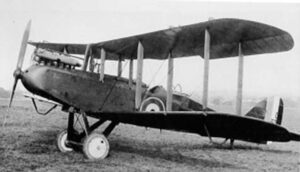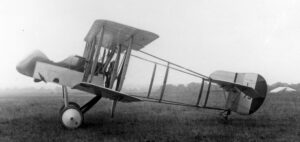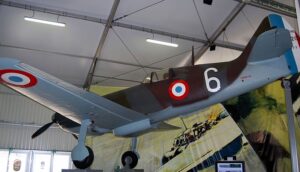During the First World War, British aircraft were mainly biplanes made of wood and fabric with a wire-braced structure. The wings were often staggered to improve the aircraft’s stability, and the fuselage was narrow and streamlined. Engines were typically rotary or inline, and the propeller was in the front of the aircraft. Open cockpits were standard, and the aircraft was steered using a stick and rudder pedals.
The British aircraft were used for a variety of roles, including reconnaissance, artillery spotting, bombing, and air-to-air combat. Many of the aircraft were designed and built by companies such as A.V. Roe and Company (Avro), Royal Aircraft Factory (RAF), and Sopwith Aviation Company.
Some of the most famous British aircraft of the First World War include the Sopwith Camel, a single-seat biplane used as a fighter aircraft; the Royal Aircraft Factory S.E.5, another single-seat fighter aircraft; and the Handley Page Type O, a twin-engine biplane used for bombing raids.
Overall, British aircraft of the First World War were generally reliable and effective, and played a key role in the development of military aviation. They were used extensively throughout the conflict and helped to shape the tactics and strategy of air warfare in the years to come.
All WW1 Aircraft and Warplanes from the United Kingdom

Hawker Fury
The Hawker Fury was a British biplane fighter aircraft designed and manufactured by Hawker Aircraft Limited in the late 1920s.

Aeromarine 75 (Felixstowe F5L)
The Aeromarine 75 or Felixstowe F5L was a military flying boat manufactured during WW1 and first flown on 15 July 1918.

SS Class Airship
The SS Class Airship were cheap and simple small non-rigid airships or “blimps” designed to counter German U-boats.

Vickers Vimy
The Vickers Vimy was a British heavy bomber manufactured by Vickers Limited and used during the latter stages of the First World War.

Royal Aircraft Factory S.E.5a
The Royal Aircraft Factory S.E.5a was a British fighter aircraft designed by the Royal Aircraft Factory and used during World War I.

Royal Aircraft Factory S.E.4a
The Royal Aircraft Factory S.E.4a was a British experimental single-engine scout aircraft designed by the Royal Aircraft Factory.

Royal Aircraft Factory S.E.2
The Royal Aircraft Factory S.E.2 was an early British single-seat scout aircraft designed by Royal Aircraft Factory and used during World War I.

Royal Aircraft Factory R.E.8
The Royal Aircraft Factory R.E.8 was a British two-seat bomber and reconnaissance biplane designed by the Royal Aircraft Factory.

Royal Aircraft Factory R.E.7
The Royal Aircraft Factory R.E.7 was a British two-seat light bomber and reconnaissance biplane designed by the Royal Aircraft Factory.

Royal Aircraft Factory R.E.5
The Royal Aircraft Factory R.E.5 was a British two-seat reconnaissance and artillery observation biplane used during World War I.

Royal Aircraft Factory R.E.1
The Royal Aircraft Factory R.E.1 was a British experimental two-seat single-engine biplane developed by the British Royal Aircraft Factory.

Royal Aircraft Factory F.E.8
The Royal Aircraft Factory F.E.8 was a British single-seat fighter designed by the Royal Aircraft Factory and used during the First World War.

Royal Aircraft Factory F.E.2
The Royal Aircraft Factory F.E.2 was a British day and night bomber and fighter used by the Royal Flying Corps during the First World War.

Royal Aircraft Factory B.E.12
The Royal Aircraft Factory B.E.12 was a British single-engine, single-seat biplane designed by the Royal Aircraft Factory and used during WW1.

Royal Aircraft Factory B.E.8
The Royal Aircraft Factory B.E.8 was a British single-engine, two-seat biplane designed by the Royal Aircraft Factory and used during WW1.

Royal Aircraft Factory B.E.1 And B.E.2
The Royal Aircraft Factory B.E.2 was a British single-engine, two-seat biplane designed by the Royal Aircraft Factory and used during WW1.

Short Type 827
The Short Type 827 (Short Admiralty Type 827) was a British two-seat reconnaissance floatplane manufactured by Short Brothers during WW1.

Short Bomber
The Short Bomber (also known as Short Type 184) was a British two-seat long-range reconnaissance, bombing and torpedo-carrying aircraft.

Sopwith 1½ Strutter
The Sopwith 1½ Strutter was a British single or double-seated multi-role biplane aircraft used during the First World War.

Sopwith Tabloid
The Sopwith Tabloid was a British biplane originally designed as a sports aircraft and later adapted for military use during World War I.

Sopwith Snipe
The Sopwith Snipe was a British single-seat biplane fighter used by the Royal Air Force (RAF) during the First World War.

Sopwith Salamander
The Sopwith Salamander was a British ground-attack aircraft designed by the Sopwith Aviation Company and used during the First World War.

Sopwith Pup
The Sopwith Pup was a British single-seat biplane fighter used by the Royal Naval Air Service and Royal Flying Corps during World War I.

Sopwith Dolphin
The Sopwith Dolphin was a British single-seat fighter aircraft used by the Royal Flying Corps during the First World War.

Vickers F.B.19
The Vickers F.B.19 was a British single-seat fighting aircraft used during World War I. It was also sometimes called the Vickers Bullet.

Vickers F.B.14
The Vickers F.B.14 was a British biplane two-seat fighter aircraft developed by Vickers Limited and used during World War I.

Vickers F.B.12
The Vickers F.B.12 was a British biplane pusher fighter aircraft developed by Vickers Limited and used during World War I.

Vickers E.S.1
The Vickers E.S.1 was an early British single-seat biplane fighter aircraft used during World War I. Only three Vickers E.S.1 were ever built.

Martinsyde G.100 and G.102
The Martinsyde G.100 (and G.102) was a British fighter bomber aircraft built by Martinsyde and used during World War I.

Martinsyde S.1
The Martinsyde S.1 was a British biplane aircraft ith a Gnome engine in tractor configuration built during the early part of World War I.

Grahame-White Type XV (“Box-Kite”)
The Grahame-White Type XV was a British trainer biplane produced before and during World War I and often referred to as a “Box-kite.”

Bristol M.1
The Bristol M.1 was a British monoplane fighter used during the Great War (WW1). Despite its promise, only 130 Bristol M.1s were constructed.

Bristol Scout
The Bristol Scout was a single-seat biplane originally designed as a racing aircraft and later used as a fast reconnaissance plane.

Avro 500 or Type E/Es
The Avro 500 or Type E/Es is a family of British military biplane aircraft and forerunner to the outstanding WW1 Avro 504.

Armstrong Whitworth F.K.8
The Armstrong Whitworth F.K.8 is a British biplane used during the First World War. It typically accompanied the better known R.E.8.

Armstrong Whitworth F.K.2 and F.K.3
The Armstrong Whitworth F.K.3 is a British two-seat biplane built during the First World War. After the conflict, it was considered obsolete.

Airco DH.9A
The Airco DH.9A is a British light bomber used shortly before the end of the Great War (WW1). It featured a strengthened structure and Puma engine.

Airco DH.9
The Airco DH.9 is a British single-engine biplane developed and used during World War I. It was ordered in large numbers by the RFC.

Airco DH.6
The Airco DH.6 is a two-seat biplane introduced in 1916 and used during World War I for training pilots and observers.

Airco DH.5
The Airco DH.5 is a single-seat biplane fighter aircraft first introduced in 1917 to replace the DH.2 and similar outdated designs.

Airco DH.4
The Airco DH.4 is a two-seat biplane airplane designed by Airco for World War I. It became one of the most successful planes of the war.

Airco DH.2
The Airco DH.2 is a single-seat biplane fighter aircraft introduced in 1915. It was the first British fighter to have a forward-firing machine gun.

Airco DH.1
The Airco DH.1 is a single-seat biplane fighter aircraft and one of the most important aircraft designers of the 20th century.

Bristol F.2 Fighter
The Bristol F.2 Fighter was a WWI British biplane aircraft used for fighting and reconnaissance and manufactured by Bristol Aeroplane Company.

Sopwith Camel
The Sopwith Camel is a British WW1 single-seat biplane fighter that was used in the Western Front in 1917.

Vickers F.B.5 Gunbus
The Vickers F.B.5 (or Fighting Biplane 5, also known as the “Gunbus”) was a British two-seat pusher military biplane used during the First World War.









